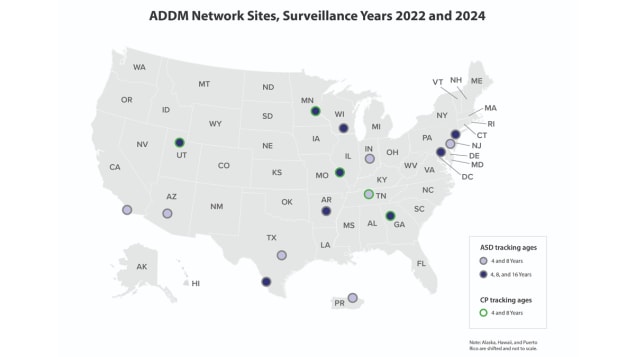Facts About CDC’s Autism and Developmental Disabilities Monitoring (ADDM) Network
Download and print this page [334 KB, 2 Pages, 508]

*11 U.S. Communities
CDC’s Autism and Developmental Disabilities Monitoring (ADDM) Network is the only collaborative network to track the number and characteristics of children with autism spectrum disorder (ASD) and cerebral palsy (CP) in multiple communities in the United States. CDC encourages partners to use information from ADDM in their local communities and across the country to move forward initiatives, policies, and research that help children and families living with ASD and CP.
What Do ADDM Data Tell Us About ASD?
From 2016 to the beginning of 2020, 4-year-old children had more evaluations and identifications than children aged 8-years (when they were 4) had from 2012 through 2016.

Displayed as 6 months prior and 6 months post-pandemic
- About 1 in 36 (2.8%) 8-year-old children living in ADDM Network sites were identified with ASD in 2020. This estimate is based on 8-year-old children living in 11 communities who participated in the ADDM Network and does not necessarily represent the entire population of children in the United States.
- For the first time, the ADDM Network found that the percentage of 8-year-old Black, Hispanic, and Asian or Pacific Islander children identified with ASD was higher than among 8-year-old White children, which was the opposite of previously observed racial and ethnic differences across the ADDM Network.
- Boys were nearly four times as likely to be identified with ASD as girls among 8-year-olds. However, the percentage of 8-year-old girls with ASD is now more than 1%.
- Intellectual disability (ID) is often seen in children with ASD and can indicate a type of impairment in intellectual ability. Among 8-year-old children with ASD, about one third (37.9%) also had ID.
- Overall, children born in 2016 were 1.6 times as likely to receive an ASD diagnosis or special education classification by 4 years (48 months) of age compared with children born in 2012.
- An analysis comparing the number of evaluations and ASD identifications before and after the onset of the COVID-19 pandemic found that before the pandemic, 4-year-old children were receiving more evaluations and identifications than 8-year-old children did when they were 4 years of age. However, these improvements in evaluation and ASD identification reversed, beginning in March 2020. Delays in evaluation could have long-lasting effects as a result of delays in identification and initiation of services during the COVID-19 pandemic.
CDC Resumes CP Activities within the ADDM Network
CDC resumed CP activities within the ADDM Network in 2023. These activities focus on tracking and monitoring CP at four funded ADDM sites, and one CDC-managed site in Georgia, known as the Metropolitan Atlanta Developmental Disabilities Surveillance Program (MADDSP). The four funded ADDM sites include Minnesota, Missouri, Tennessee, and Utah. Tracking and monitoring CP can help raise awareness of signs and symptoms, identify causes and risk factors, and evaluate the effectiveness of prevention efforts.
Stay up to date with CDC’s CP activities across the ADDM Network by visiting https://www.cdc.gov/ncbddd/cp/addm-network-methods-cp.html.
Building the Public Health Infrastructure for ASD and CP

To understand the scope of developmental disabilities in the United States, Congress passed the Children’s Health Act of 2000, helping to pave the way for CDC to create the ADDM Network which has enabled CDC to better track the number and characteristics of children with ASD and other developmental disabilities in diverse communities over many years. Using CDC’s MADDSP as a tracking guide, the ADDM Network has now been collecting and reporting ASD data from across the United States for more than twenty years—while also gathering information on other developmental disabilities, such as CP, along the way. There are several major advantages to using the ADDM method for tracking the number and characteristics of children with ASD and CP:
- The ADDM method is population-based. CDC monitors ASD and CP among thousands of children from diverse communities across the country.
- ADDM tracks how many children have ASD and CP, which groups of children are more likely to be identified with ASD or CP, and at what age they are likely to be diagnosed.
- ADDM findings reflect real-world community practices. Differences in ASD and CP identification among communities suggest opportunities to identify and serve children with ASD and CP more equitably.
Find out more about CDC’s ADDM Network sites.
Moving Forward
CDC will continue to monitor the number and characteristics of children with ASD and CP and track progress in the early identification of ASD and CP. ADDM Network sites also monitor health and transition planning needs among 16-year-old adolescents with ASD.
States and communities have the potential to turn ADDM Network data into action. These findings can be used in local communities and nationwide to advance initiatives, policies, and research that help children with ASD and CP.
Learn More
- CDC’s Autism and Developmental Disabilities Monitoring Network: www.cdc.gov/addm
- CDC’s Learn the Signs. Act Early. Program: www.cdc.gov/actearly
